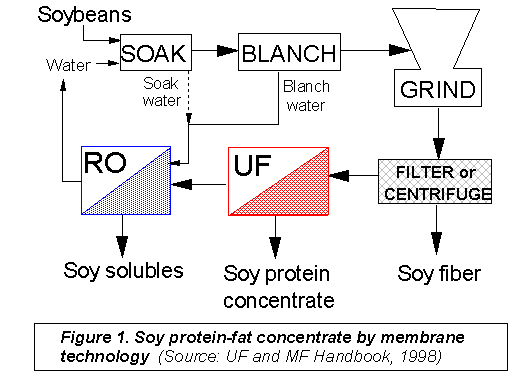|
PLANT (VEGETABLE)
PROTEINS Plant or vegetable protein products have been consumed for centuries in Asia and Middle Eastern countries. It was not until the mid-20th century that the western world recognized their food value, especially that of soybeans. With the growing interest in reducing the consumption of animal products for health and economic reasons, plant proteins are making up a higher proportion of the human diet in recent years. Soybeans (18-20% oil) are the major source of edible oil in the United States and by far the most important source of vegetable protein ingredients. However, after the oil is removed, the remaining soybean meal is used mostly as animal feed, with perhaps less than 10% being used directly for human food. The problem with soybeans is that it also contains some undesirable components that must be removed or reduced to increase the usefulness and functionality of the soybean protein (almost all sources of plant protein share this problem). For example, soybeans contain oligosaccharides that have been implicated with gastrointestinal stress. Lipid-lipoxygenase interactions must be avoided to prevent painty off-flavors from developing. Phytic acid forms insoluble chelates with minerals and can form complexes with proteins that reduce bioavailability of the minerals and proteins. Trypsin inhibitors are proteinaceous compounds that affect the efficiency of protein digestion.
Traditional processing techniques for producing soy protein concentrates and isolates partially overcome these problems. These methods involve extraction, heat treatment and centrifugation to separate the protein and fat from the other components. These conventional methods are time-consuming, they sometimes result in products with poor functional properties, and can generate a whey-like waste stream which contains a significant portion of the proteinaceous compounds of the starting material.
We have developed alternate processes for purifying vegetable proteins and removing many objecionable flavor compounds using membrane technology. Since the undesirable oligosaccharides, phytic acid and some of the trypsin inhibitors are smaller in molecular size than proteins and fat components, it should be possible, by careful selection of the membrane and operating parameters, to selectively remove these undesirable components and produce a purified protein isolate or lipid-protein concentrate (depending on the starting material) with superior functional properties.
Full-fat soy protein concentrates (soymilk) Table 1. Composition of soy products (% dry basis) produced by ultrafiltration of water extracts of soybeans
*By difference. Includes fiber, other carbohydrate **Trypsin Units Inhibited/mg solids
Soy protein concentrates and isolates
Removal of oligosaccharides follows theoretical predictions and is relatively unaffected by operating parameters. However, removal of phytic acid is affected by pH. Phytic acid has a molecular weight of 880 and should be easily removed by UF. However, it is a negatively charged compound and can bind directly with soy protein by charge interactions at low pH, or through a divalent cation bridge at high pH. Thus the pH, nature and concentration of other charged compounds present during ultrafiltration has a profound effect on the removal of phytic acid. UF at pH 8.5 or pH 3 results in strong binding of phytate to the protein, and thus no removal will occur. Charge interactions are minimized near the isoelectric point of the protein (pH 5). Divalent cations become more soluble and binding of phytate to the protein decreases, thus allowing it to be removed. Adding EDTA to the extract at high pH or excess calcium at low pH also effectively reduces the binding.
The manufacture of soy products by ultrafiltration usually results in higher yields because of the inclusion of the whey proteins that are normally lost in conventional manufacturing methods. These whey proteins could also be contributing to the superior functional properties of the UF soy products, in addition to the benefits of the nonthermal and nonchemical nature of the UF process. Our laboratory has done work on several plant proteins, such as corn (maize), sunflower(Helianthus annus) and dry beans (Phaseolus vulgaris L.). More details are available in our publications list. Some material has been excerpted from Ultrafiltration and Microfiltration Handbook by Munir Cheryan, Ph.D., published by CRC Press, Boca Raton, FL(1998). More details and references available in this book.  Publications on this topic Publications on this topic Research -- Other topics Research -- Other topics Updated July 2009 by mcheryan@uiuc.edu |

